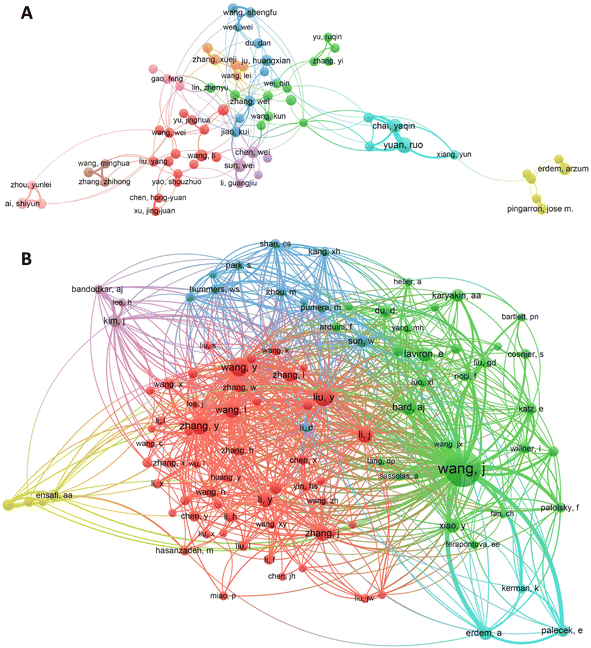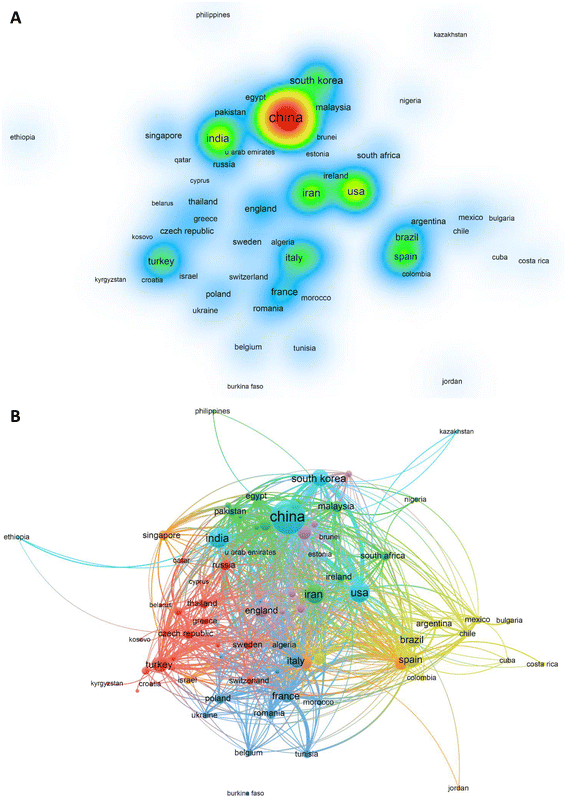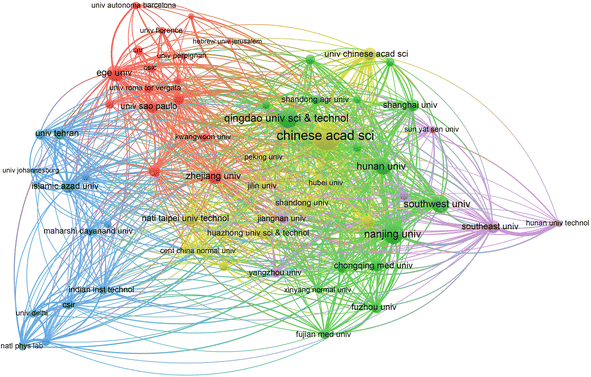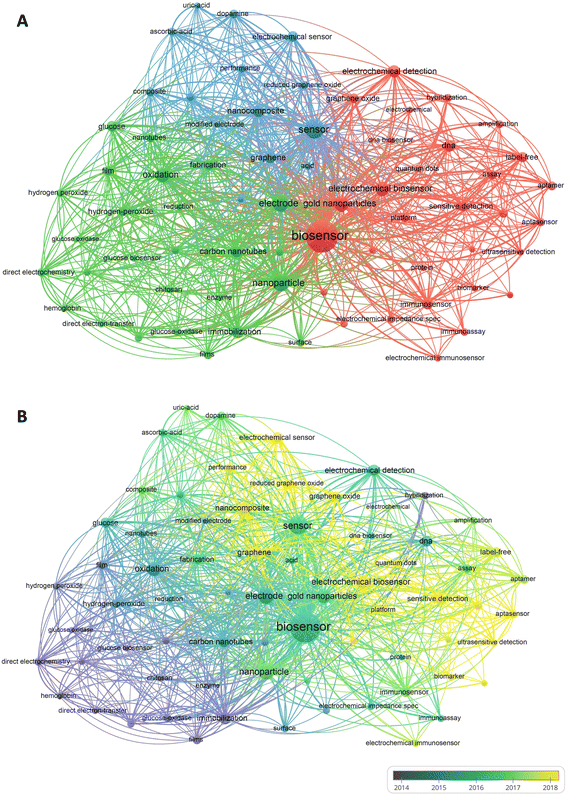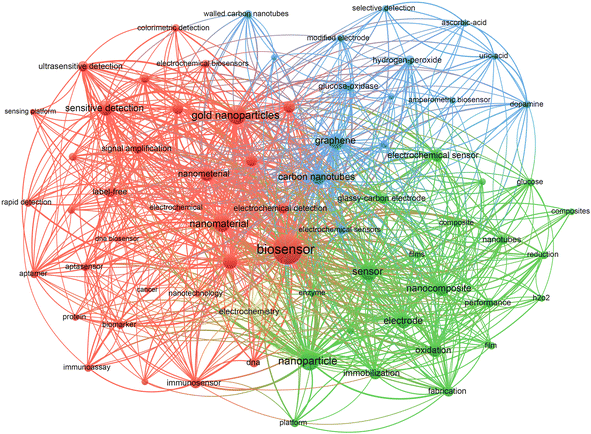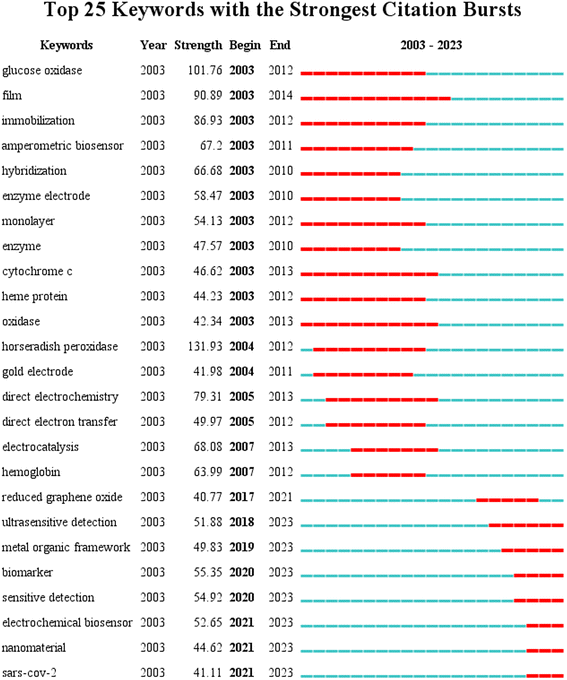 Open Access Article
Open Access ArticleCreative Commons Attribution 3.0 Unported Licence
Hotspots and trends of electrochemical biosensor technology: a bibliometric analysis from 2003 to 2023†
Lan Li‡
a,
Yi Li‡
a,
Jingwen Peia,
Yu Wua,
Guobing Wanga,
Jing Zhangb,
Jinbo Liu*a and
Gang Tian *a
*a
aDepartment of Laboratory Medicine, The Affiliated Hospital of Southwest Medical University, Sichuan Province Engineering Technology Research Center of Molecular Diagnosis of Clinical Diseases, Molecular Diagnosis of Clinical Diseases Key Laboratory of Luzhou, Sichuan, China. E-mail: tiangang@swmu.edu.cn
bDivision of Basic Biomedical Sciences, The University of South Dakota Sanford School of Medicine, Vermillion, South Dakota 57069, USA
First published on 19th October 2023
Abstract
As a powerful tool for biological sensing, electrochemical biosensors have attracted much attention due to their ability to integrate biological recognition elements on an electrochemical interface and convert target analyte information into measurable electrochemical signals. Despite the abundance of literature published on the topic, no comprehensive surveys have been conducted to evaluate the area of electrochemical biosensors with bibliometric techniques. This paper employs VOSviewer to analyze and visualize literature from 2003 to 2023 in the Web of Science in order to gain an understanding of the development of the field of electrochemical biosensors in recent years. Co-occurrence and co-citation analysis are employed to identify research hotspots, trace evolutionary paths, and comprehend development trends in the field. Moreover, by analyzing highly cited and representative literature from different time periods, it is possible to recognize the major research hotspots and grasp the development pulse. The results of this study provide a comprehensive overview of the field of electrochemical biosensors and can be used to guide future research.
1. Introduction
Biosensors are composed of three main components: receptors, physicochemical transducers, and signal processors.1,2 Depending on the type of transducer, biosensors can be categorized into electrochemical,3 optical,4 and thermal sensitive varieties. Electrochemical sensors are particularly useful due to their low cost, easy operation, portability, fast response, and high sensitivity. Bioelectronic sensors are made by combining biological or chemical components with electronic detecting technologies and attaching physiologically sensitive elements like antigens, antibodies, enzymes, hormones, or the organism itself to electrodes. Due to the specific recognition between biomolecules, target molecules, or electroactive molecules, this enables the transformation of reaction signals into electrical signals like capacitance, current, potential, and conductivity, which in turn enables the qualitative or quantitative detection of target analytes.5 These features make electrochemical biosensors suitable for on-site rapid detection in clinical diagnostics,2 food,6,7 and environmental monitoring.8Bibliometrics is a systematic discipline formed through the integration of mathematics, statistics, bibliography, big data analysis and other disciplines that can quantitatively analyse resources or knowledge in a certain field.9–11 It has important applications in various fields. It can scientifically manage publications, core documents and library information, and can also design a more time-saving and labour-saving information network system to process information efficiently.12 More and more medical workers use bibliometrics to carry out information management on relevant data in the medical field, capture and analyse the information of published journal documents, including the number of published papers, published authors, journal institutions, published journals, institution regions, and funding situation. Visual analysis can be used to find different types of groups by clustering the measurement indicators based on the relationship strength and direction. Further analysis of the connection and correlation degree of its highly cited documents, popular keywords, and subject terms can be done to synthesize these research results and summarize the current research status of the content.13,14 Moreover, bibliometric analysis has been employed in research on electrochemiluminescence and electrochemical biosensors in healthcare services.15–17 However, there has been no comprehensive bibliometric analysis of electrochemical biosensors reported in the literature. To bridge this gap, bibliometric analysis was employed in this study. 23![[thin space (1/6-em)]](https://www.rsc.org/images/entities/char_2009.gif) 090 related literature of electrochemical biosensors were retrieved from the Web of Scientific Core Collection Database and analysed the annual publication trend, literature categories, authors, journals, articles, institutions, and keywords by VOSviewer and CiteSpace. This allowed for the summarization of the research progress of electrochemical biosensors over the past two decades, as well as the determination of the research hotspots and development trends.
090 related literature of electrochemical biosensors were retrieved from the Web of Scientific Core Collection Database and analysed the annual publication trend, literature categories, authors, journals, articles, institutions, and keywords by VOSviewer and CiteSpace. This allowed for the summarization of the research progress of electrochemical biosensors over the past two decades, as well as the determination of the research hotspots and development trends.
2. Data sources and analysis methods
2.1. Data source
The Web of Science Core Collection database was chosen as the data source for this study due to its wide coverage of publications from different fields and its high-quality digital literature resource, which is widely regarded as the best database for bibliometric analysis.18,19 The search sentence used was “TS = (electrochemical biosensor)”, indexed in SSCI and ESCI, and with a time span of 2003.01.01 to 2023.06.30. No language or document type limitations were set, with the document types including original articles and review articles. After eliminating duplicated entries from the search results, a total of 24![[thin space (1/6-em)]](https://www.rsc.org/images/entities/char_2009.gif) 294 journal papers were obtained. Subsequently, to make sure that the chosen articles concerned the electrochemical biosensor, a manual review was conducted to examine the content of each article (including the paper title and abstract) to exclude any irrelevant publications. Consequently, 23
294 journal papers were obtained. Subsequently, to make sure that the chosen articles concerned the electrochemical biosensor, a manual review was conducted to examine the content of each article (including the paper title and abstract) to exclude any irrelevant publications. Consequently, 23![[thin space (1/6-em)]](https://www.rsc.org/images/entities/char_2009.gif) 090 articles were kept for content and bibliometric mapping analysis, comprising of 20
090 articles were kept for content and bibliometric mapping analysis, comprising of 20![[thin space (1/6-em)]](https://www.rsc.org/images/entities/char_2009.gif) 312 (88.0%) articles and 2778 (12.0%) reviews (Table 1).
312 (88.0%) articles and 2778 (12.0%) reviews (Table 1).
| Category | Specific standard equipment |
|---|---|
| Research database | Web of science core collection |
| Citation indexes | SSCI and SCIE |
| Searching period | 2003-01-01 to 2023-06-30 |
| Search sentence | “TS = (electrochemical biosensor)” |
| Document types | “Articles” and “Review articles” |
| Data extraction | Export with full records and cited references in plain text format |
| Studies excluded (N = 1204) | Duplicates (N = 20) not related to electrochemical biosensor (N = 1184) |
| Sample size | 23![[thin space (1/6-em)]](https://www.rsc.org/images/entities/char_2009.gif) 090 090 |
2.2. Data analysis
GraphPad Prism (version 9.5) was utilized to generate bar charts, while VOSviewer (version 1.6.19) and CiteSpace (version win5.7. R5) were employed to conduct data visualization, creating scientific landscapes and networks based on citation frequency, countries, journals, authors, and other information.3. Results
3.1. Annual publication trend
The data presented in Fig. 1A indicates an overall increase in the number of publications related to electrochemical biosensors from 2003 to 2023. The number of articles published is gradually increasing every year. Since 2013, the annual publication volume has been consistently above 1000 articles, reaching 2114 in 2022. As of April 30th in 2023, 854 articles have been published, and it is expected that the number of publications in 2023 will exceed 2300. This trend suggests that electrochemical biosensors have become an increasingly popular research topic, and further growth in the number of publications is likely as researchers continue to explore the molecular mechanisms and nanomaterials associated with this field.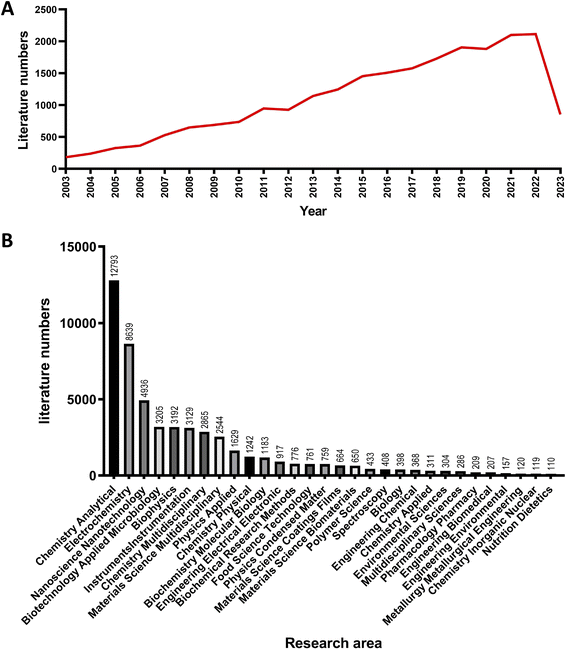 | ||
| Fig. 1 (A) Published literature on electrochemical biosensor from 2003 to 2023. (B) Published literature of electrochemical biosensor in different categories. | ||
3.2. Analysis of literature categories
According to Web of Science subject categories, all these literature are assigned to different research areas. Top 30 research areas ranked by publication counts are exhibited in Fig. 1B. The most involved area is the chemical analysis (54.3%) with 12![[thin space (1/6-em)]](https://www.rsc.org/images/entities/char_2009.gif) 793 publications, followed by electrochemistry (8639 publications) and nanoscience (4936 publications). The number of publications related to biotechnology, applied microbiology, biophysics and instruments is roughly equivalent.
793 publications, followed by electrochemistry (8639 publications) and nanoscience (4936 publications). The number of publications related to biotechnology, applied microbiology, biophysics and instruments is roughly equivalent.
3.3. Analysis of authors
Authors totalling 57![[thin space (1/6-em)]](https://www.rsc.org/images/entities/char_2009.gif) 912 collaborated to publish 23
912 collaborated to publish 23![[thin space (1/6-em)]](https://www.rsc.org/images/entities/char_2009.gif) 090 papers, with the transient authors accounting for 68.5% (39
090 papers, with the transient authors accounting for 68.5% (39![[thin space (1/6-em)]](https://www.rsc.org/images/entities/char_2009.gif) 659) of the total. 1479 authors published more than 10 articles in this field, with the most prolific author being Ruo Yuan, who published228 articles from 2003 to June 2023. Yaqin Chai was the second most prolific author, with 154 publications. The top five cited authors are Ruo, Y, Huangxian, J, Yaqin, C, Joseph, W and Shen-ming, C. The top 10 most prolific authors are presented in Fig. 2A.
659) of the total. 1479 authors published more than 10 articles in this field, with the most prolific author being Ruo Yuan, who published228 articles from 2003 to June 2023. Yaqin Chai was the second most prolific author, with 154 publications. The top five cited authors are Ruo, Y, Huangxian, J, Yaqin, C, Joseph, W and Shen-ming, C. The top 10 most prolific authors are presented in Fig. 2A.
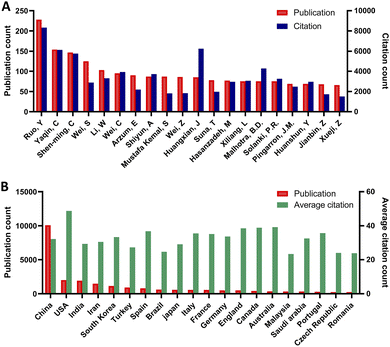 | ||
| Fig. 2 (A) Top 10 most prolific authors. (B) Top 10 most prolific countries/regions according to publication numbers. | ||
From Fig. 3A, we can see that the authors with a high volume of publications in the field of electrochemical biosensor have formed multiple cooperation networks, and the cooperation within each network is relatively close, but the cooperation between networks is relatively small. Professor Ruo Yuan and Yaqin Chai from Southwest University had a strong bond of cooperation, with a relative link strength of 151.
Analysis of author co-citation revealed that 102 authors with at least 500 citations were included. Total link strength reflects the impact of an author's documents on other authors participating in the research. As illustrated in Fig. 3B, the top three authors with the highest total link strength were Wang, J, Wang, Y, and Liu, Y.
3.4. Analysis of published journals
The research conducted has revealed that the retrieved documents were published in 1162 different journals. Table 2 highlights the 20 most active journals in publishing articles on electrochemical biosensors. Biosensors and Bioelectronics was the most prolific journal in this field, with 2485 publications, followed by Sensors and Actuators B: Chemical with 1545 publications, and Electroanalysis with 939 publications. The top 20 journals in total accounted for 56.6% of all documents retrieved. Citations analysis of the 369 journals with at least 5 publications indicated that Biosensors and Bioelectronics had the highest citation numbers (N = 139![[thin space (1/6-em)]](https://www.rsc.org/images/entities/char_2009.gif) 852), followed by Sensors and Actuators B: Chemical (N = 58
852), followed by Sensors and Actuators B: Chemical (N = 58![[thin space (1/6-em)]](https://www.rsc.org/images/entities/char_2009.gif) 173), and Analytical Chemistry (N = 47
173), and Analytical Chemistry (N = 47![[thin space (1/6-em)]](https://www.rsc.org/images/entities/char_2009.gif) 103). Fig. 4 displays the density map of journals citation analysis.
103). Fig. 4 displays the density map of journals citation analysis.
| Rank | Journal | Documents | Citations | IF (2023) |
|---|---|---|---|---|
| 1 | Biosensors and Bioelectronics | 2485 | 139![[thin space (1/6-em)]](https://www.rsc.org/images/entities/char_2009.gif) 852 852 |
12.600 |
| 2 | Sensors and Actuators B: Chemical | 1545 | 58![[thin space (1/6-em)]](https://www.rsc.org/images/entities/char_2009.gif) 173 173 |
9.221 |
| 3 | Electroanalysis | 939 | 21![[thin space (1/6-em)]](https://www.rsc.org/images/entities/char_2009.gif) 809 809 |
3.007 |
| 4 | Talanta | 775 | 26![[thin space (1/6-em)]](https://www.rsc.org/images/entities/char_2009.gif) 979 979 |
6.556 |
| 5 | Microchimica Acta | 663 | 16![[thin space (1/6-em)]](https://www.rsc.org/images/entities/char_2009.gif) 290 290 |
6.408 |
| 6 | Analytical Chemistry | 662 | 47![[thin space (1/6-em)]](https://www.rsc.org/images/entities/char_2009.gif) 103 103 |
8.008 |
| 7 | Analytica Chimica Acta | 647 | 25![[thin space (1/6-em)]](https://www.rsc.org/images/entities/char_2009.gif) 471 471 |
6.911 |
| 8 | Electrochimica Acta | 632 | 24![[thin space (1/6-em)]](https://www.rsc.org/images/entities/char_2009.gif) 196 196 |
6.600 |
| 9 | Journal of Electroanalytical Chemistry | 614 | 14![[thin space (1/6-em)]](https://www.rsc.org/images/entities/char_2009.gif) 835 835 |
4.598 |
| 10 | Sensors | 487 | 16![[thin space (1/6-em)]](https://www.rsc.org/images/entities/char_2009.gif) 202 202 |
3.847 |
| 11 | International Journal of Electrochemical Science | 477 | 5843 | 1.541 |
| 12 | Journal of The Electrochemical Society | 435 | 5672 | 4.386 |
| 13 | Analyst | 432 | 14![[thin space (1/6-em)]](https://www.rsc.org/images/entities/char_2009.gif) 107 107 |
5.227 |
| 14 | Biosensors-Basel | 381 | 3799 | 5.743 |
| 15 | Bioelectrochemistry | 361 | 9588 | 5.760 |
| 16 | Analytical Methods | 352 | 5288 | 3.532 |
| 17 | RSC Advances | 344 | 7258 | 4.036 |
| 18 | Analytical and Bioanalytical Chemistry | 311 | 10![[thin space (1/6-em)]](https://www.rsc.org/images/entities/char_2009.gif) 655 655 |
4.478 |
| 19 | Microchemical Journal | 271 | 3179 | 5.304 |
| 20 | ACS Applied Materials & Interfaces | 245 | 11![[thin space (1/6-em)]](https://www.rsc.org/images/entities/char_2009.gif) 320 320 |
10.383 |
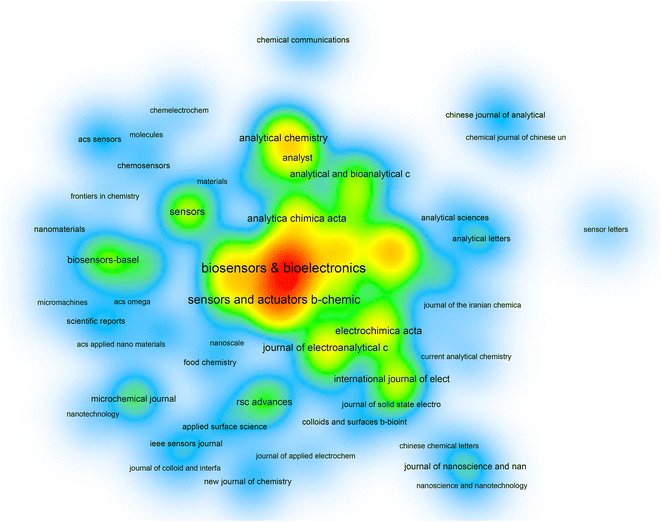 | ||
| Fig. 4 Density visualization of citation analysis for 65 journals with a minimum productivity of 50 documents. Journals with a greater amount of citations are represented by darker spots. | ||
3.5. Analysis of top cited articles
The 23![[thin space (1/6-em)]](https://www.rsc.org/images/entities/char_2009.gif) 090 papers that were retrieved were cited 732
090 papers that were retrieved were cited 732![[thin space (1/6-em)]](https://www.rsc.org/images/entities/char_2009.gif) 598 times in total. Of these, 1286 (5.6%) had at least one hundred citations, while 1852 (4.0%) had no citations. Table 3 displays the top 20 most cited papers, comprising of 12 reviews and 8 articles, coming from China (N = 5), USA (N = 5), and the remaining from South Korea, Israel, Singapore, Canada, Ireland, Spain, United Kingdom, France and Lithuania. The highest citation number of 1369 was for the article “Biological and Chemical Sensors Based on Graphene Materials” published in Chemical Society Reviews.20 A comprehensive review of graphene materials and graphene-based electrochemical biosensors. It is followed by the article “Wearable biosensors for healthcare monitoring” published by Kim J. et al. on Nature Biotechnology in 2019.21 An overview analysis of wearable biosensors via dynamic, non-invasive measurements. It can be seen from the highly cited documents that most of them are related to new materials, rapid detection and non-invasive detection, which shows that cooperation between different disciplines and technologies is necessary in order to develop forward.
598 times in total. Of these, 1286 (5.6%) had at least one hundred citations, while 1852 (4.0%) had no citations. Table 3 displays the top 20 most cited papers, comprising of 12 reviews and 8 articles, coming from China (N = 5), USA (N = 5), and the remaining from South Korea, Israel, Singapore, Canada, Ireland, Spain, United Kingdom, France and Lithuania. The highest citation number of 1369 was for the article “Biological and Chemical Sensors Based on Graphene Materials” published in Chemical Society Reviews.20 A comprehensive review of graphene materials and graphene-based electrochemical biosensors. It is followed by the article “Wearable biosensors for healthcare monitoring” published by Kim J. et al. on Nature Biotechnology in 2019.21 An overview analysis of wearable biosensors via dynamic, non-invasive measurements. It can be seen from the highly cited documents that most of them are related to new materials, rapid detection and non-invasive detection, which shows that cooperation between different disciplines and technologies is necessary in order to develop forward.
| Rank | Author | Title | Year | Source title | Cited by | IF | Country | Document type |
|---|---|---|---|---|---|---|---|---|
| 1 | Liu, YX et al. | Biological and chemical sensors based on graphene materials | 2012 | Chemical Society Reviews | 1369 | 46.2 | China | Review |
| 2 | Kim, J et al. | Wearable biosensors for healthcare monitoring | 2019 | Nature Biotechnology | 1312 | 46.9 | USA | Review |
| 3 | Shan, CS et al. | Direct electrochemistry of glucose oxidase and biosensing for glucose based on graphene | 2009 | Analytical Chemistry | 1161 | 8.0 | China | Article |
| 4 | Katz, E et al. | Probing biomolecular interactions at conductive and semiconductive surfaces by impedance spectroscopy: routes to impedimetric immunosensors, DNA-sensors, and enzyme biosensors | 2003 | Electroanalysis | 1154 | 3.0 | Israel | Review |
| 5 | Ronkainen, NJ et al. | Electrochemical biosensors | 2010 | Chemical Society Reviews | 1120 | 46.2 | USA | Review |
| 6 | Kuila, T et al. | Recent advances in graphene-based biosensors | 2011 | Biosensors and Bioelectronics | 1013 | 12.6 | South Korea | Review |
| 7 | Song, SP et al. | Aptamer-based biosensors | 2008 | TrAC Trends in Analytical Chemistry | 1003 | 13.1 | China | Article |
| 8 | Pumera, M et al. | Graphene for electrochemical sensing and biosensing | 2010 | TrAC Trends in Analytical Chemistry | 964 | 13.1 | Singapore | Review |
| 9 | Hrapovic, S | Electrochemical biosensing platforms using platinum nanoparticles and carbon nanotubes | 2004 | Analytical Chemistry | 925 | 8.0 | Canada | Article |
| 10 | Daniels, JS et al. | Label-free impedance biosensors: opportunities and challenges | 2007 | Electroanalysis | 893 | 3.0 | USA | Review |
| 11 | Lin, YH et al. | Glucose biosensors based on carbon nanotube nanoelectrode ensembles | 2004 | Nano Letters | 834 | 10.8 | USA | Article |
| 12 | Jacobs, CB et al. | Review: carbon nanotube based electrochemical sensors for biomolecules | 2010 | Analytica Chimica Acta | 805 | 6.9 | USA | Review |
| 13 | Chen, W et al. | Recent advances in electrochemical sensing for hydrogen peroxide: a Review | 2012 | Analyst | 787 | 5.2 | China | Review |
| 14 | Velusamy, V et al. | An overview of foodborne pathogen detection: In the perspective of biosensors | 2010 | Biotechnology Advances | 780 | 16.0 | Ireland | Review |
| 15 | Pingarron, JM et al. | Gold nanoparticle-based electrochemical biosensors | 2008 | Electrochimica Acta | 756 | 6.6 | Spain | Review |
| 16 | Chang, BY et al. | Electrochemical impedance spectroscopy | 2010 | Annual Review of Analytical Chemistry | 723 | 12.4 | South Korea | Article |
| 17 | Toghill, KE et al. | Electrochemical non-enzymatic glucose sensors: a perspective and an evaluation | 2010 | International Journal of Electrochemical Science | 716 | 1.5 | United Kingdom | Article |
| 18 | Sassolas, a et al. | Immobilization strategies to develop enzymatic biosensors | 2012 | Biotechnology Advances | 708 | 16.0 | France | Review |
| 19 | Ramanavicius, a et al. | Electrochemical sensors based on conducting polymer-polypyrrole | 2006 | Electrochimica Acta | 696 | 6.6 | Lithuania | Article |
| 20 | Guo, SJ et al. | Platinum nanoparticle ensemble-on-graphene hybrid nanosheet: one-pot, rapid synthesis, and used as new electrode material for electrochemical sensing | 2010 | ACS Nano | 693 | 17.1 | China | Article |
3.6. Analysis of countries/regions
120 countries/regions were represented in the geographical distribution of publications. 15 countries only published one article, while 71 countries published more than ten. It is evident from Fig. 2B that China is the most productive country in terms of the number of published articles, accounting for 43.7% of the total, significantly higher than the second-ranked USA with 2002 articles. Among the top 20 most prolific countries, United States had the greatest citation numbers per publication (48.7), followed by Australia (39.2) and Canada (38.9). Fig. 5A further illustrates that China has the most citations, far exceeding other countries, followed by the United States, India, Iran, and South Korea. Fig. 5B provides a visualization map of the country co-authorship analysis conducted by VOSviewer, which indicates that China is situated in the centre of the network. The presented node connecting line portrays the intensity of the association, where a thicker line indicates the greater number of articles released through collaboration of two countries. As per the collaboration analysis, China is seen to have the highest degree of centrality, followed by the USA, with both countries exhibiting a close cooperation. Similarly, India, Iran and South Korea have also developed a strong connection. Close cooperation and exchanges between countries contribute to the rapid development of this field.3.7. Analysis of institutions
As shown in Table 4, the Chinese Academy of Sciences in China was the most prolific institution in the publication of papers on electrochemical biosensors, with 774 publications. This was followed by Qingdao University of Science & Technology in China (449 publications) and Nanjing University in China (434 publications). Of the top 10 prolific institutions, 8 were in China, 1 was in Turkey, and 1 was in Iran. Additionally, 63 organizations were cited at least 3000 times, as shown in Fig. 6. The Chinese Academy of Sciences had the highest citation number with 36![[thin space (1/6-em)]](https://www.rsc.org/images/entities/char_2009.gif) 245 citations, followed by Nanjing University (25
245 citations, followed by Nanjing University (25![[thin space (1/6-em)]](https://www.rsc.org/images/entities/char_2009.gif) 551 citations) and Qingdao University of Science & Technology (13
551 citations) and Qingdao University of Science & Technology (13![[thin space (1/6-em)]](https://www.rsc.org/images/entities/char_2009.gif) 621 citations).
621 citations).
| Rank | Organization | Documents | Country |
|---|---|---|---|
| 1 | Chinese Academy of Sciences | 774 | China |
| 2 | Qingdao University of Science & Technology | 449 | China |
| 3 | Nanjing University | 434 | China |
| 4 | Southwest University | 344 | China |
| 5 | Hunan University | 317 | China |
| 6 | Ege University | 262 | Turkey |
| 7 | Zhejiang University | 224 | China |
| 8 | Southeast University | 199 | China |
| 9 | Islamic Azad University | 194 | Iran |
| 10 | University of Chinese Academy of Sciences | 193 | China |
3.8. Analysis of keywords
The analysis of keyword co-occurrence revealed the research hotspots in this field.15 Table 5 lists the top 10 keywords with the highest frequency of occurrence, with “biosensor” being the most mentioned. Fig. 7A illustrates the three clusters identified among the top 70 keywords, based on the frequency of co-occurrence. The cluster led by “biosensor” and “gold nanoparticles” had the highest number of occurrences, followed by the cluster led by “sensor” and “nanoparticles”, and then the cluster led by “oxidation” and “immobilization”. Fig. 7B is the keyword overlay map, showing the trend of keywords over time. The yellow nodes depicted in the figure signify emerging keywords, suggesting that they could be indicative of ongoing research studies; such keywords include sensitive detection, ultrasensitive detection, rapid detection, nanocomposite, and signal amplification, all of which have been frequently cited in the last two years and may be potential research hotspots in the future. The network visualization of keywords of the top five most prolific countries are shown in Fig. S1–S5.† The keywords in the five countries are basically the same, and the top five are “biosensor”, “sensor”, “nanoparticle”, “electrode” and “gold nanoparticles”.| Rank | Keyword | Occurrences | Cluster |
|---|---|---|---|
| 1 | Biosensor | 11![[thin space (1/6-em)]](https://www.rsc.org/images/entities/char_2009.gif) 917 917 |
1 |
| 2 | Sensor | 4816 | 3 |
| 3 | Nanoparticle | 3869 | 3 |
| 4 | Electrode | 3513 | 3 |
| 5 | Gold nanoparticles | 2825 | 1 |
| 6 | Oxidation | 2656 | 2 |
| 7 | Electrochemical biosensor | 2470 | 1 |
| 8 | Immobilization | 2069 | 2 |
| 9 | Graphene | 1728 | 3 |
| 10 | Carbon nanotubes | 1674 | 2 |
To further analyse the application of nanomaterials in electrochemical biosensors, we conducted keyword analysis on 717 articles using the search formula “(TS = (electrochemical biosensor)) ANDTS = (nanomaterial)”, as shown in Fig. 8. The results indicate that nanomaterials such as gold nanoparticles, graphene, and carbon nanotubes are the most commonly utilized in the field of electrochemical biosensors.
Keyword burst detection is a useful tool for identifying research frontiers and emerging topics in a particular field over time.22 A burst keyword is one that appears frequently in a given period of time, providing insight into the evolution of research hotspots and trends. To gain a better understanding of the development of electrochemical biosensor research, the top 25 keyword terms with the strongest emergent strength analysed from 2003 to 2023 are illustrated in Fig. 9. Biomarkers and their associated characteristics have undoubtedly become a subject of great interest among scholars since 2020, and will likely remain a point of focus in the future. Biomarkers are biological substances or activities that can be quantitatively measured and evaluated to indicate normal biological processes, pathogenic processes, or responses to therapeutic interventions. Recently, electrochemical biosensors have been increasingly employed for the detection of biomarkers. Since 2019, the spread of Coronavirus Disease (COVID-19), caused by Severe Acute Respiratory Syndrome Coronavirus 2 (SARS-CoV-2), has been a global concern, resulting in numerous fatalities and significant economic losses.23,24 As a result, the development of specific and sensitive detection methods for COVID-19 has become a priority.25 Additionally, nanomaterials are being explored as a potential future research trend, as nanobiosensors can provide high sensitivity and portability, potentially leading to the development of new clinical and field-deployable analytical instruments.26,27
4. Discussion
Electrochemical biosensors, as a growing and useful detection method, have been continually improved with the advancement of the medical field. This study utilizes VOSviewer software to review the development of electrochemical sensors in the past two decades, analysing the core authors, high-productivity international institutions, key journals, and keywords in the field. Our findings indicate that the amount of literature on electrochemical biosensors is on an overall upward trend, from 183 articles in 2003 to 2114 articles in 2022, with the number of articles increasing 11.5 times. Similar to our findings, prior bibliometric analyses have demonstrated that the amount of literature on biosensors and electrochemiluminescence sensing technology is growing in general.15,17 It is clear that electrochemical biosensors are a gradually growing field.It is noteworthy that Joseph Wang from the University of California had a central position in the co-citation map, despite having a relatively small number of publications. This could be attributed to several highly-cited publications from him.21,28 Wang's research interests focus on electrochemical biosensors, wearable devices and microrobots. Similarly, Huangxian, J published only half as many articles as Yaqin, C, but her citations were higher than Yaqin, C. This result suggests that the number of publications may not always be an accurate indicator of an author's academic influence, as there are many factors that can influence an article's citation frequency. Publications of Chinese scholars occupied the leading position, but its average citation rate ranks 12th. This is because quantity remains the measuring stick at the university and the national levels.29 Reward and promotion systems which eschew quantity measures and value fewer, deeper, more novel contributions could inspire more innovative and high-quantity work.30
Research on national cooperation networks can help to promote teamwork and global cooperation in specific areas. In this study, we can see that the country with the highest number of publications is China, followed by the USA and India. Furthermore, China has the highest degree of centrality, indicating that it plays an important role as a bridge in intercountry cooperation. Cooperation as a conventional development modality, which sharing resources has become a trend in global research. Based on this current situation, strengthening communication and cooperation between national institutions is of profound importance in promoting further development in this field. The analysis of author collaboration networks and author co-citations helps to analyse the direction of authors' research and provides further guidance. The study shows that many scholars have formed collaborative networks centred on themselves and have a more consistent article output. Overall, there is a lack of collaboration between scholars and teams, and enhanced communication and cooperation between authors could have far-reaching implications in promoting further development in the field. Future author collaboration could produce more good quality articles.
Electrical signal changes are the basis of signal production in electrochemical biosensing systems, which can be detected by changes in current and resistance. The majority of electrochemical biosensor studies are classified as chemistry analytical and electrochemistry due to the presence of oxidation–reduction processes.
Electrochemical biosensors have been widely utilized for clinical diagnosis, food analysis, and environmental monitoring, and they have made remarkable progress in detecting not only bacteria, hormones, and total metal ions, but also disease biomarkers, which has become a popular research topic in recent years and is believed to be an effective approach for exploring disease biology and managing diseases.31 Biomarkers are molecular indicators of a biological state or condition, which can be proteins, protein fragments, DNA/RNA, or organic chemicals produced by abnormal cells. Disease biomarkers are essential for the early detection and accurate staging of a disease, as they serve as a molecular representation of the physiological state of the disease at a given time.32 Disease biomarkers, due to their ability to provide information on the initiation of a disease, allow for powerful methods for diagnosis and treatment. Electrochemical biosensors are advantageous due to their convenience and timely analysis, making them key components in biomarker detection. In the future, the combination of biomarkers discovered through mechanistic studies, biochemical analysis, and other methods with rapid and accurate electrochemical biosensors will be an essential research trend.
As medicine continues to advance, the demand for trace biomolecule detection and point-of-care diagnostics has increased, making the simplification of operation procedures and shortening of detection time for analytical methods increasingly important. The fabrication of electrochemical biosensors with superior selectivity, high sensitivity, and fast response is of great importance. Signal amplification is a commonly used method to raise the detection sensitivity in biosensors. With the advancement of functional materials, nanomaterials and nanotechnology have been extensively studied by scientists in various domains. The advancement of nanotechnology has been remarkable, and nanomaterials have been highly sought after for their exceptional properties, leading to the development of nanomaterial sensors with remarkable sensitivity and accuracy for diagnostic purposes, thus improving the performance of biosensors in terms of sensitivity, detection limit, selectivity and repeatability.33,34 According to the analysis of the application of nanomaterials in electrochemical biosensors, graphene, carbon nanotubes and gold nanoparticles have displayed exceptional capabilities for electrochemical biosensing. Among the top 20 highly cited articles, nine articles are all related to nanomaterials.
From a scientific bibliometrics perspective, the research lineage produced from this study is immensely beneficial, offering researchers insight into potential research paths and ideas in this area. Specifically: (1) it can help scholars who are interested in the application of electrochemical biosensors to establish a clear framework of the existing research in this field, and gain an in-depth understanding of the development process of this field; (2) the clustering of high-frequency keywords and the analysis of the evolution of the keywords can help scholars to understand the focus and hotspot of the field of electrochemical biosensors, which can provide scholars with references for choosing the topics of research; (3) the analysis of core papers and core authors in the field of electrochemical biosensors can help scholars quickly find the literature they want to refer to in their research; (4) the analysis of journals in this field can provide scholars with a guide to select journals to a certain extent when they submit their papers in this topic.
This paper has certain limitations, as the papers selected for the international study were only screened from the two major indexes of the Web of Science database, and other scientific databases (e.g., Scopus) were not taken into account. This may lead to an incomplete analysis of the data, thus the next study should expand the scope of the literature screening to gain a more comprehensive understanding of the research and the cutting-edge hotspots in the field of electrochemical biosensors. This will help to improve and deepen the knowledge of the field, while also avoiding as much as possible the subjectivity of personal analysis and interpretation, in order to provide a more reliable review and analysis. In addition, since the number of citations of a document is affected by its publication time, the citations of high-quality literature published in 2023 may not have reached the ideal level, which may lead to a delay in the discovery of research fronts.
5. Conclusions
In the current age, biosensors have been extensively used in a variety of fields, including biological diagnostics, environmental monitoring, food safety, drug research, and tracking the progression of diseases at the point-of-care. In the last two decades, China has been the leading contributor to electrochemical biosensor research, with more than half of the top 10 most productive institutions and authors being from the country. Most of the research papers were published in methodological journals, with the main focuses being biomarker, ultrasensitive detection, and nanomaterial.Author contributions
Lan Li: conceptualization, methodology, software, writing – original draft. Yi Li: data curation, writing – original draft preparation. Jingwen Pei: visualization, data curation. Yu Wu: formal analysis, software. Guobing Wang: software, validation. Jing Zhang: writing – reviewing and editing. Jinbo Liu: writing – reviewing and editing, supervision. Gang Tian: supervision, funding acquisition. All authors have read and approved the manuscript.Conflicts of interest
The authors declare that the research was conducted in the absence of any commercial or financial relationships that could be construed as a potential conflict of interest.Acknowledgements
This study was supported by grants from the Luzhou Science and Technology Department Applied Basic Research program (no. 2022-JYJ-145), and the Sichuan Province Science and Technology Department of foreign (border) high-end talent introduction project (no. 2023JDGD0037), and the Luzhou City - School Industry-University Research Cooperation Cultivation Project (no. 2020LZXNYD02).Notes and references
- D. R. Thévenot, K. Toth and R. A. Durst, et al., Electrochemical Biosensors: Recommended Definitions and Classification, Biosens. Bioelectron., 2001, 16(1–2), 121–131 CrossRef PubMed.
- V. S. P. K. S. A. Jayanthi, A. B. Das and U. Saxena, Recent Advances in Biosensor Development for the Detection of Cancer Biomarkers, Biosens. Bioelectron., 2017, 91, 15–23 CrossRef CAS PubMed.
- B. V. Chikkaveeraiah, A. A. Bhirde and N. Y. Morgan, et al., Electrochemical Immunosensors for Detection of Cancer Protein Biomarkers, ACS Nano, 2012, 6(8), 6546–6561 CrossRef CAS PubMed.
- X. Fan, I. M. White and S. I. Shopova, et al., Sensitive Optical Biosensors for Unlabeled Targets: A Review, Anal. Chim. Acta, 2008, 620(1–2), 8–26 CrossRef CAS PubMed.
- X. Yang and H. Cheng, Recent Developments of Flexible and Stretchable Electrochemical Biosensors, Micromachines, 2020, 11(3), 243 CrossRef PubMed.
- A. Curulli, Electrochemical Biosensors in Food Safety: Challenges and Perspectives, Molecules, 2021, 26(10), 2940 CrossRef CAS PubMed.
- J. Shao, C. Wang and Y. Shen, et al., Electrochemical Sensors and Biosensors for the Analysis of Tea Components: A Bibliometric Review, Front. Chem., 2021, 9, 818461 CrossRef CAS PubMed.
- S. Uniyal and R. K. Sharma, Technological Advancement in Electrochemical Biosensor Based Detection of Organophosphate Pesticide Chlorpyrifos in the Environment: A Review of Status and Prospects, Biosens. Bioelectron., 2018, 116, 37–50 CrossRef CAS PubMed.
- A. Diem and S. C. Wolter, The Use of Bibliometrics to Measure Research Performance in Education Sciences, Res. Higher Educ., 2013, 54(1), 86–114 CrossRef.
- P. Mayr and A. Scharnhorst, Scientometrics and Information Retrieval: Weak-Links Revitalized, Scientometrics, 2015, 102(3), 2193–2199 CrossRef.
- Z. Xu, X. Gao and B. Ren, et al., A Bibliometric Analysis of Segmentectomy versus Lobectomy for Non-Small Cell Lung Cancer Research (1992-2019), Medicine, 2021, 100(13), e25055 CrossRef PubMed.
- M. Wu, Y. Jiang and R. W. M. Kwong, et al., How Do Humans Recognize and Face Challenges of Microplastic Pollution in Marine Environments? A Bibliometric Analysis, Environ. Pollut., 2021, 280, 116959 CrossRef CAS PubMed.
- G. Abramo, C. A. D'Angelo and F. Viel, The Field-Standardized Average Impact of National Research Systems Compared to World Average: The Case of Italy, Scientometrics, 2011, 88(2), 599–615 CrossRef.
- P. Antwi-Afari, S. T. Ng and M. U. Hossain, A Review of the Circularity Gap in the Construction Industry through Scientometric Analysis, J. Clean. Prod., 2021, 298, 126870 CrossRef.
- X. Liu, S. Zhao and L. Tan, et al., Frontier and Hot Topics in Electrochemiluminescence Sensing Technology Based on CiteSpace Bibliometric Analysis, Biosens. Bioelectron., 2022, 201, 113932 CrossRef CAS PubMed.
- G. Yunus, R. Singh and S. Raveendran, et al., Electrochemical Biosensors in Healthcare Services: Bibliometric Analysis and Recent Developments, PeerJ, 2023, 11, e15566 CrossRef PubMed.
- N. Olson and J. Bae, Biosensors-Publication Trends and Knowledge Domain Visualization, Sensors, 2019, 19(11), 2615 CrossRef CAS PubMed.
- F. Havemann, J. Gläser and M. Heinz, et al., Identifying Overlapping and Hierarchical Thematic Structures in Networks of Scholarly Papers: A Comparison of Three Approaches, PLoS One, 2012, 7(3), e33255 CrossRef CAS PubMed.
- X. Ding and Z. Yang, Knowledge Mapping of Platform Research: A Visual Analysis Using VOSviewer and CiteSpace, J. Electron. Commer. Res., 2022, 22(3), 787–809 CrossRef.
- Y. Liu, X. Dong and P. Chen, Biological and Chemical Sensors Based on Graphene Materials, Chem. Soc. Rev., 2012, 41(6), 2283–2307 RSC.
- J. Kim, A. S. Campbell and B. E.-F. de Ávila, et al., Wearable Biosensors for Healthcare Monitoring, Nat. Biotechnol., 2019, 37(4), 389–406 CrossRef CAS PubMed.
- X.-D. Zhang, Y. Zhang and Y.-Z. Zhao, et al., Autoimmune Pancreatitis: A Bibliometric Analysis from 2002 to 2022, Front. Immunol., 2023, 14, 1135096 CrossRef CAS PubMed.
- C. Huang, Y. Wang and X. Li, et al., Clinical Features of Patients Infected with 2019 Novel Coronavirus in Wuhan, China, Lancet, 2020, 395(10223), 497–506 CrossRef CAS PubMed.
- E. Janik, M. Bartos and M. Niemcewicz, et al., SARS-CoV-2: Outline, Prevention, and Decontamination, Pathogens, 2021, 10(2), 114 CrossRef CAS PubMed.
- S. Mao, L. Fu and C. Yin, et al., The Role of Electrochemical Biosensors in SARS-CoV-2 Detection: A Bibliometrics-Based Analysis and Review, RSC Adv., 2022, 12(35), 22592–22607 RSC.
- B. Bali Prasad, A. Kumar and R. Singh, Synthesis of Novel Monomeric Graphene Quantum Dots and Corresponding Nanocomposite with Molecularly Imprinted Polymer for Electrochemical Detection of an Anticancerous Ifosfamide Drug, Biosens. Bioelectron., 2017, 94, 1–9 CrossRef CAS PubMed.
- J. Kneipp, Interrogating Cells, Tissues, and Live Animals with New Generations of Surface-Enhanced Raman Scattering Probes and Labels, ACS Nano, 2017, 11(2), 1136–1141 CrossRef CAS PubMed.
- J. Wang, Carbon-Nanotube Based Electrochemical Biosensors: A Review, Electroanalysis, 2005, 17(1), 7–14 CrossRef CAS.
- C. Baden-Fuller, F. Ravazzolo and T. Schweizer, Making and Measuring Reputations: The Research Ranking of European Business Schools, Long Range Plann., 2000, 33(5), 621–650 CrossRef.
- J. S. G. Chu and J. A. Evans, Slowed Canonical Progress in Large Fields of Science, Proc. Natl. Acad. Sci. U. S. A., 2021, 118(41), e2021636118 CrossRef CAS PubMed.
- J. A. Ludwig and J. N. Weinstein, Biomarkers in Cancer Staging, Prognosis and Treatment Selection, Nat. Rev. Cancer, 2005, 5(11), 845–856 CrossRef CAS PubMed.
- N. Rifai, M. A. Gillette and S. A. Carr, Protein Biomarker Discovery and Validation: The Long and Uncertain Path to Clinical Utility, Nat. Biotechnol., 2006, 24(8), 971–983 CrossRef CAS PubMed.
- G. Maduraiveeran, M. Sasidharan and V. Ganesan, Electrochemical Sensor and Biosensor Platforms Based on Advanced Nanomaterials for Biological and Biomedical Applications, Biosens. Bioelectron., 2018, 103, 113–129 CrossRef CAS PubMed.
- L. Qian, S. Durairaj and S. Prins, et al., Nanomaterial-Based Electrochemical Sensors and Biosensors for the Detection of Pharmaceutical Compounds, Biosens. Bioelectron., 2021, 175, 112836 CrossRef CAS PubMed.
Footnotes |
| † Electronic supplementary information (ESI) available. See DOI: https://doi.org/10.1039/d3ra05889a |
| ‡ These authors contributed equally to the work. |
| This journal is © The Royal Society of Chemistry 2023 |



